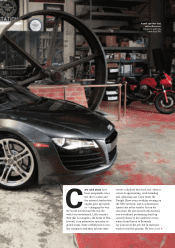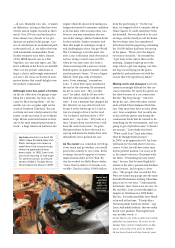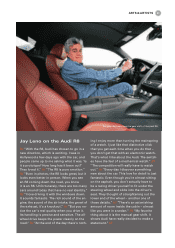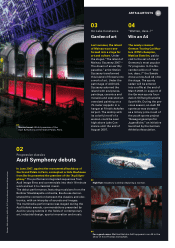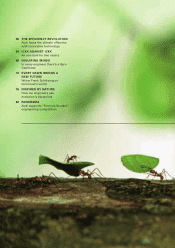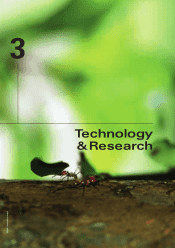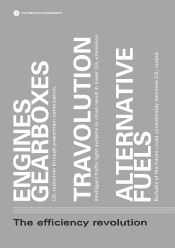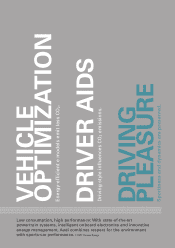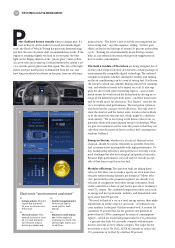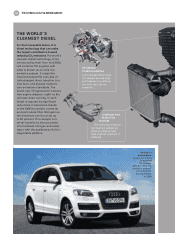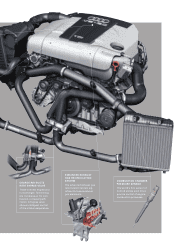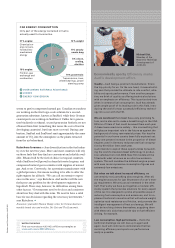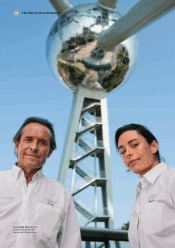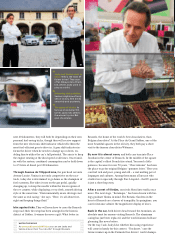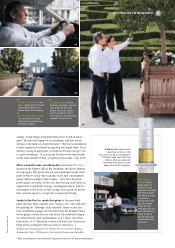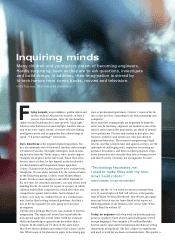Audi 2007 Annual Report Download - page 61
Download and view the complete annual report
Please find page 61 of the 2007 Audi annual report below. You can navigate through the pages in the report by either clicking on the pages listed below, or by using the keyword search tool below to find specific information within the annual report.
“We are working hard on all aspects of our cars to
reduce consumption and emissions even further. On engines,
natu-rally, but also on weight, aerodynamics, transmissions,
energy management and so on,” says Audi Chairman Rupert
Stadler. The successful trend toward downsized engines with
higher boost pressure is continuing. Thanks to direct injection,
turbocharging, high torque, reduced cylinder capacity and
lower friction losses, many of Audi’s TFSI (turbocharged fuel-
stratified injection) gasoline engines and TDI (turbocharged
direct injection) diesel powerplants are already the best in
their class. Engine optimization is still key, but the layman
tends to overestimate the fuel-saving potential achievable via
this route. In this context, it helps to look at how the energy
contained in fuel is translated in the vehicle. In other words:
Which parts use how much fuel?
Just under one-third of the energy is lost as the engine
converts chemical into mechanical energy. This is a law of
physics that not even the best engineer in the world can
change. A further 19 percent disappears due to friction, gas
exchange inside the cylinder and combustion method. Effi-
ciency gains can still be made in these areas, but the efforts
made in the engine department need to be combined with oth-
er measures, because 19 percent of energy is eaten up by the
powertrain, i.e. transmission, tires, wheel bearings and power
steering pump. Air conditioning and electrics demand a fur-
ther eight percent. Weight and aerodynamic resistance count
for just under one-quarter of the consumed energy. “In the
future, we’ll be taking our modular efficiency system even
further,” says Gebhard. Specifically, this means that many
Audi models with efficient TDI and TFSI powertrain systems
will be fitted with an innovative energy management system
that exploits coasting and braking phases to generate electric-
ity. This will be stored in new high-performance accumulators,
among others, to be used when the car stops or when it is ac-
celerating, relieving the burden on the alternator and onboard
electrical system, thus saving fuel. Another benefactor of
the new accumulator is the new start-stop system, which sig-
nificantly reduces consumption in city centers with intersec-
tions. An extremely economical air conditioning system,
transmission heating to improve gearbox efficiency, tires with
reduced roll resistance and a further reduction in air drag
are a few of the other tools available with the modular effi-
ciency system.
The world’s cleanest diesel. Audi will continue to pay
special attention to clean diesel technology. This is because
Continued on page 62
Like hydrogen, second-
generation biofuels are seen
to have a particularly promis-
ing future. Large-scale pro-
duction methods are under
development. This second
generation will not compete
with the production of food-
stuffs, and will gradually
replace fossil fuels. Today,
SunFuel and SunDiesel can
already be mixed with regu-
lar diesel, and in the future,
they will reduce CO2output
by up to 90 percent.
The future of fuel
Gasoline/diesel
Combustion
engines, hybrids
today 10 years 20 years >20 years
Gasoline/diesel
10 % biogen
SynFuels
Optimized
combustion
engines,
hybrids
Gasoline/diesel
20 % biogen
SynFuels
SunFuels
Hydrogen
Optimized
combustion
engines, hybrids,
fuel cells (small
series)
Gasoline/diesel
>20 % biogen
SynFuels
SunFuels
Hydrogen
Optimized
combustion
engines,
hybrids, fuel
cells
FOSSIL FUELS
Crude oil/natural gas/coal CO2REGENERATIVE FUELS
Wind/sun/water/biomass/waste
specific CO2emissions [CO2g/km]
“We need to think
of a car as a total
energy system.”
Peter Gebhard,
Head of Vehicle Testing,
AUDI AG
Audi A5 2.0 T CNG
concept car: The
4-cylinder engine
has been designed
to run on gasoline
and natural gas. The
Compressed Natural
Gas (CNG) is held by
lightweight pressure
tanks. The gasoline
tank holds 14 liters.


